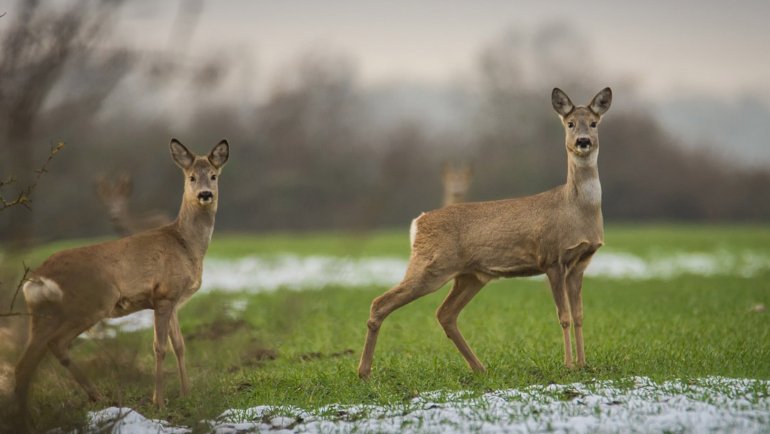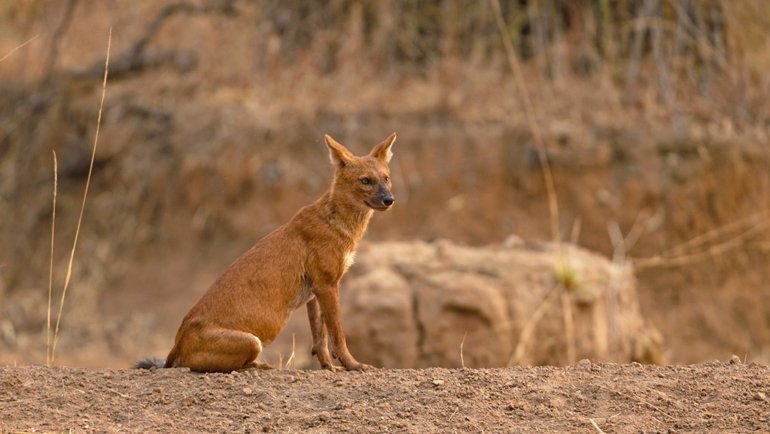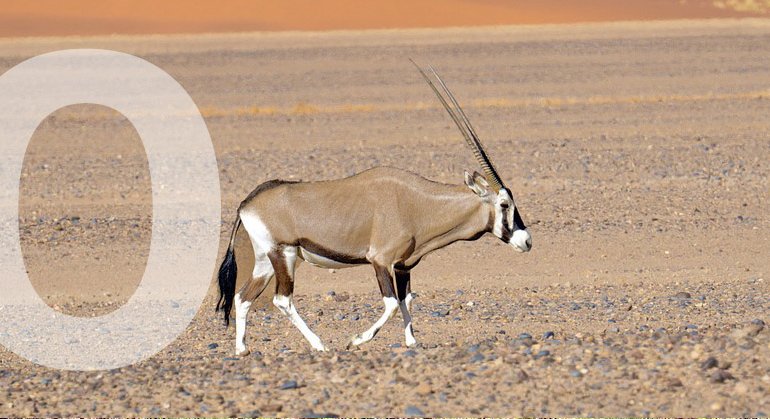In the vast expanse of the wild, two canids stand out as icons of their respective terrains: the African Wild Dog of the African plains and the wolf spread across North America, Europe, and Asia. These apex predators, while separated by thousands of miles and entirely distinct ecosystems, share certain striking similarities and differences.
Beyond their captivating appearances and pack behaviors lies a myriad of characteristics that tell stories of evolution, adaptation, and survival. This article delves into a comparison of these two magnificent species, unraveling the physical and behavioral distinctions that make them unique.
African Wild Dog vs. Wolf: Overview
| Feature | African Wild Dog | Wolf |
|---|---|---|
| Scientific Name | Lycaon pictus | Canis lupus |
| Size | 75-110 cm (30-43 inches) in length | 100-165 cm (39-65 inches) in length |
| Weight | 18-36 kg (40-79 lbs) | 30-80 kg (66-176 lbs) |
| Geographic Range | Sub-Saharan Africa | North America, Europe, Asia |
| Habitat | Savannahs, grasslands, light forests | Forests, tundras, grasslands |
| Lifespan | 10-12 years | 6-8 years (wild), Up to 15 in captivity |
| Running Speed | Up to 60 km/h (37 mph) | Up to 75 km/h (47 mph) |
| Bite Force | Approx. 317 psi | 400-1,200 psi |
| Pack Size | 6-20 members | 6-10 members |
| Conservation Status | Endangered | Varies (e.g., Gray wolf is “Least Concern”, Red wolf is critically endangered) |
Physical Differences
Size and Build
The African plains see the slender and agile African Wild Dog, a creature built for endurance. Weighing between 40 to 70 pounds, this canid is constructed for long chases across open terrains, using its lean structure to its advantage. The wild dog’s slender legs and light frame allow for swift movements, and their bodies are notably designed for effective heat dissipation, a crucial trait for survival under the scorching African sun.
The wolf, on the other hand, exudes power and strength. Depending on the subspecies and region, a wolf can weigh anywhere between 70 to 145 pounds. With a robust physique, wolves are armed for strength-driven ambushes. Their powerful jaws can exert immense pressure, a necessity for bringing down larger prey like elks or moose in the dense forests or icy tundras they call home.
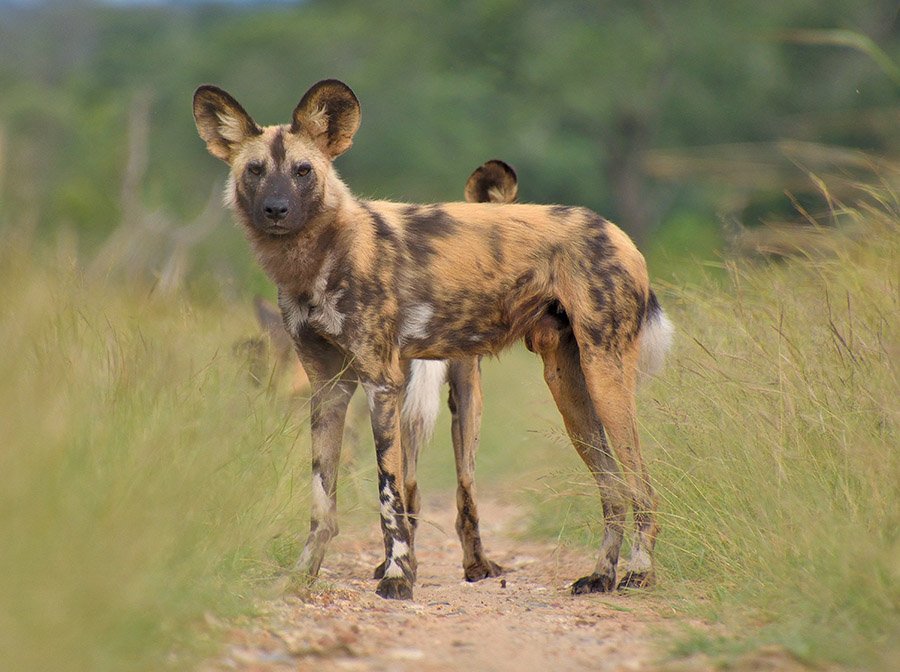
Appearance
One of the most captivating features of the African Wild Dog is its coat. A mosaic of brown, black, white, and yellow patches, every individual sports a unique pattern—a beautiful chaos of colors that provides camouflage in the grasslands. Moreover, their large, rounded ears are not just tools for acute hearing but also function as radiators to dissipate heat, keeping the dogs cool during hunts.
Wolves present a more muted but equally mesmerizing palette. From the pristine whites seen in the Arctic wolves to the mix of grays and browns in the more common gray wolves, their coat colors often mirror their environments. Unlike the wild dog’s mottled appearance, wolves have a more uniform coat, often with a darker dorsal side transitioning to a lighter ventral side.
Their straight, upright ears and intense eyes give them a regal and piercing look, a true representation of their position atop the food chain in their habitats.
Habitats and Distribution
African Wild Dog
The African Wild Dog thrives primarily in the savannahs, grasslands, and light forests of sub-Saharan Africa. These terrains offer vast expanses for the wild dog to engage in their characteristic long-chase hunting strategy. Light forests and shrubs provide refuge, while the vast grasslands serve as the stage for their dramatic hunting displays.
These areas also offer ample prey options, from the agile impala to the sturdy wildebeest. However, the wild dog’s range has shrunk dramatically due to human encroachment, and they’re now confined to several pockets across Africa, making them one of the continent’s most endangered predators.
Wolf
The wolf boasts of a more expansive range, populating a diverse array of habitats across the Northern Hemisphere. You can find them in the dense forests of North America and Europe, the tundras of the Arctic, and even in the grasslands and mountains of Asia.
Each habitat has led to subtle adaptations in the wolf’s behavior and appearance. For instance, the Arctic wolf, with its thick white fur, is well-equipped to handle the icy conditions of the far north.
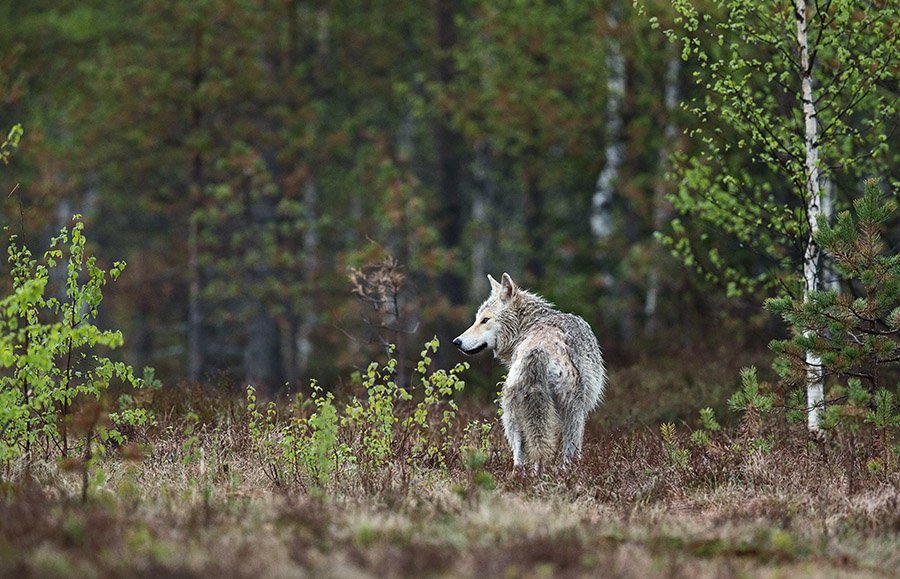
Social Structures and Behaviors
Both the African Wild Dog and the wolf are known for their intricate social structures, revolving around the concept of the pack.
Pack Sizes and Hierarchies: African Wild Dog packs can range from a close-knit group of 6 to a formidable unit of over 20. In contrast, wolf packs typically consist of a nuclear family, averaging 5-11 members, but can vary based on prey availability and region.
Role of Alphas, Betas, and Omegas: At the helm of both canid structures are the alphas – often a male and female pair who lead the pack and are typically the primary breeding pair. Following them are the betas, which act as secondary leaders or enforcers.
At the pack’s bottom rung are the omegas, who often play a submissive role. While wolves strictly adhere to this hierarchy, wild dog social structures are more fluid, with less aggression between ranks and more communal rearing of pups.
Territorial Behaviors and Inter-Pack Dynamics: Both species are territorial, marking their domains with scent markings. Wolves, given their broader range, often have larger territories than wild dogs. Inter-pack dynamics differ too. While wolf packs might engage in fierce territorial disputes, wild dogs are more likely to avoid such conflicts, especially if there are pups involved.

Hunting Strategies
African Wild Dog
These lithe predators employ a strategy of endurance. Relying on their stamina, they chase prey over long distances, wearing them down over time.
Their cooperative nature shines during these hunts, with pack members communicating and coordinating to isolate and corner their target. Wild dogs have one of the highest hunting success rates in the animal kingdom, often attributed to this team-based approach.
Wolf
Wolves are masters of the ambush. Using stealth and the element of surprise, they get close to their prey before launching a rapid assault. While they also employ cooperation, especially when hunting larger prey like elk or bison, their strategies lean more towards tracking and ambush rather than prolonged chases. Depending on the terrain and prey, wolves have varied success rates, though they are undeniably effective hunters.
In both species, the type of prey plays a significant role. While wild dogs might favor medium-sized ungulates like impalas, wolves have a broader palate, taking on anything from small rodents to massive elks.
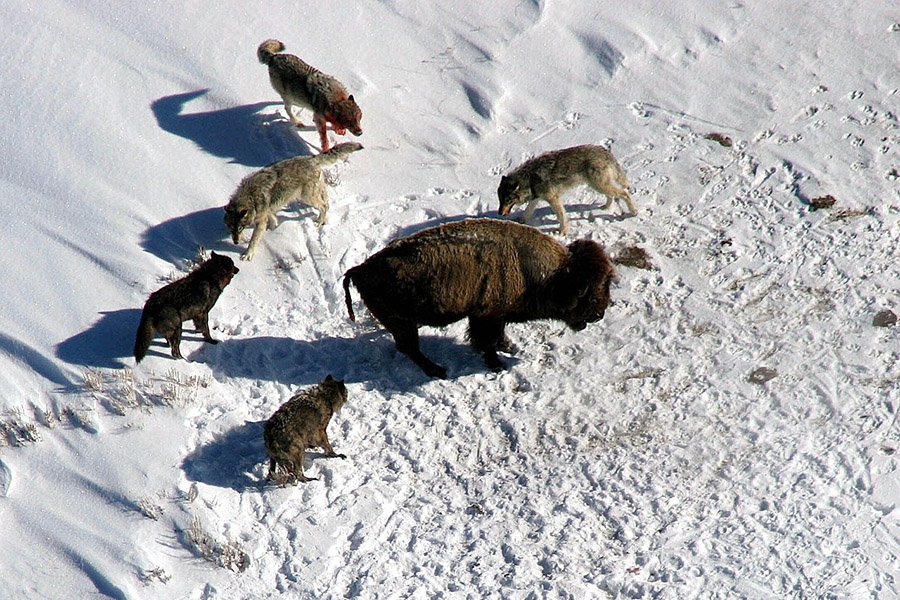
Reproductive Behaviors
Mating Rituals and Seasons
African Wild Dogs: Typically, only the dominant alpha pair breeds, ensuring that limited resources are devoted to a single litter of pups. Their breeding season can vary based on the region, but it often aligns with the local abundance of prey, ensuring the best chances for pup survival.
Wolves: Like the wild dogs, usually only the alpha pair in a wolf pack breeds. The breeding season generally occurs once a year during the winter months. Courtship behaviors include physical affection, vocalizations, and scent-marking.
Raising of Pups and Pack Involvement
African Wild Dogs: After a gestation period of about 70 days, the alpha female finds a den—often an abandoned aardvark hole—to give birth. The entire pack then becomes involved in the care of the pups, regurgitating food for them, standing guard, and even babysitting. This communal effort ensures high pup survival rates.
Wolves: Wolves give birth in dens made in secluded locations like caves or burrowed holes. The first few months see the mother staying close, with other pack members bringing food. As the pups grow, they’re introduced to pack life, learning the intricacies of being a wolf through play and observation.
Lifespan and Stages of Life
African Wild Dogs: Their lifespan ranges between 10 to 12 years in the wild. Pups transition to adulthood around 12-14 months, and by 3 years, some might leave to form or join other packs.
Wolves: In the wild, wolves live about 6-8 years, though in captivity, they can reach up to 15 years. They reach maturity by 2 years old and might disperse from their natal pack to find new territories and mates.
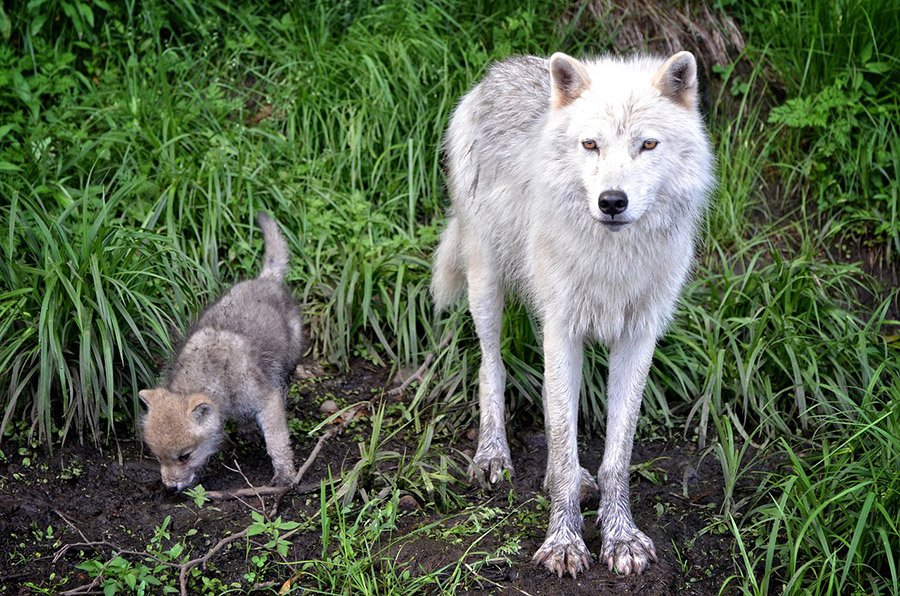
Conservation Status and Threats
Currently listed as endangered, African Wild Dogs face numerous threats. Rapid habitat loss, primarily due to human expansion, has fragmented their once-vast territories. Moreover, they often come into conflict with local communities, leading to retaliatory killings. Diseases, particularly those transmitted from domestic dogs, also pose significant risks.
The conservation status of wolves varies based on the specific subspecies. For instance, the gray wolf, once hunted and eradicated from vast parts of its range, has seen a resurgence in numbers due to conservation efforts and is listed as of “Least Concern.”
However, other species, like the red wolf, face critical endangerment. Common threats to wolves include hunting, both for trophy and in response to livestock predation, habitat loss, and human conflict.
African Wild Dog vs. Wolf: Who Would Win a Fight?
Whenever two apex predators are brought into the discussion, a common question arises: who would win in a direct confrontation? Just keep in mind that such scenarios are purely hypothetical as the two animals do not share the same geographical range and would likely never encounter each other in the wild!
While it’s almost impossible to predict the outcome definitively due to various factors and conditions, we can make some educated guesses based on their known attributes:
- Size and Strength: Generally, wolves, especially species like the gray wolf, are larger and heavier than African Wild Dogs. This size advantage can translate to more power and strength in a one-on-one confrontation.
- Aggression and Experience: Wolves, being apex predators in their respective habitats, regularly deal with threats and challenges from other large predators, such as bears or cougars. This experience might give them an edge. African Wild Dogs, on the other hand, are used to dealing with threats from larger African predators like lions or hyenas, but they usually employ avoidance tactics rather than direct confrontation.
- Pack Dynamics: Both animals excel in teamwork. If it’s a pack against a pack, then tactics, numbers, and the terrain will play a significant role. African Wild Dogs have impeccable coordination, but wolves too have a structured pack hierarchy and hunting strategy.
- Defensive Tactics: African Wild Dogs, with their agility and stamina, might avoid direct confrontations, trying to tire out the wolf. Wolves, with their thicker fur, might have some protection against bites.
- Offensive Tactics: A wolf has a stronger bite force, which could be lethal if it manages to get a solid grip. However, the nimbleness of the African Wild Dog should not be underestimated.
Conclusion: While on paper, a wolf might seem to have the advantage due to its size and strength, the outcome of such a confrontation would likely be determined by numerous factors, including the individuals’ health, experience, age, and environmental factors. Remember, these are wild animals with instincts for survival, not combatants in an arena. In nature, animals often avoid unnecessary battles that could lead to injury.
Frequently Asked Questions
Which is larger, the African Wild Dog or the Wolf?
The wolf is generally larger. While African Wild Dogs typically weigh up to 30 kg (66 lbs) and stand about 30 inches tall, wolves can weigh up to 80 kg (175 lbs) and stand around 36 inches tall.
Do African Wild Dogs and Wolves coexist in the wild?
No, they do not. African Wild Dogs are native to Africa, while wolves are found in North America, Europe, Asia, and parts of Africa separate from the wild dog’s range.
How do the hunting strategies of these animals differ?
Both species use pack-based hunting techniques, but while African Wild Dogs rely more on endurance running to tire their prey, wolves can employ both tracking and ambush strategies.
Are both species endangered?
The African Wild Dog is classified as endangered due to habitat loss and human-wildlife conflicts. Wolves vary in their conservation status based on the species and region. For example, the gray wolf has been removed from the U.S. Endangered Species List in some states but remains protected in others.
Which has a stronger bite, an African Wild Dog or a Wolf?
The wolf has a stronger bite force. Wolves have one of the strongest bite forces among canids, measured at over 1,200 psi, while the bite force of an African Wild Dog is comparatively less.
Is it true that African Wild Dogs cannot be tamed like wolves were to create domestic dogs?
While there have been instances of certain wild animals being tamed, African Wild Dogs have not been domesticated like wolves. Their social structure, behaviors, and needs make them unsuitable for domestication.
Learn More About African Wild Dogs
- African Wild Dog: Characteristics, Diet, Facts & More [Fact Sheet]
- African Wild Dog Habitat: Where Do Painted Dogs Live?
- Why Are African Wild Dogs Endangered? All About The Threats They Face
- African Wild Dog vs. Hyena: Their Key Differences & Who Would Win a Fight?
- 32 Really Cool Facts About African Wild Dogs
- What Do African Wild Dogs Eat? An Exploration of Their Diet
- African Wild Dog Bite Force: Into the Jaws of The Painted Dog
- Can African Wild Dogs Be Domesticated and Be Pets?
- African Wild Dog Predators: Their Top 5 Natural Enemies
- Are African Wild Dogs Dangerous? Do They Attack Humans?
- The Secrets Behind The African Wild Dog’s Hunting Success Rate

